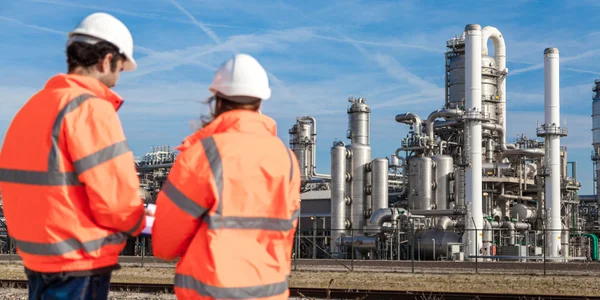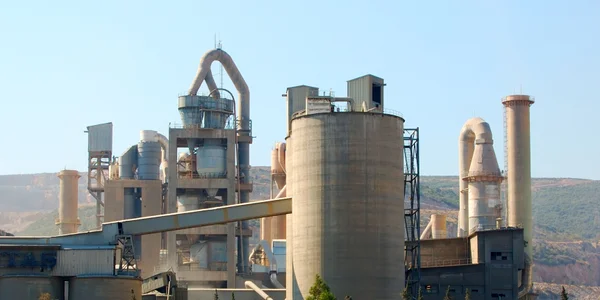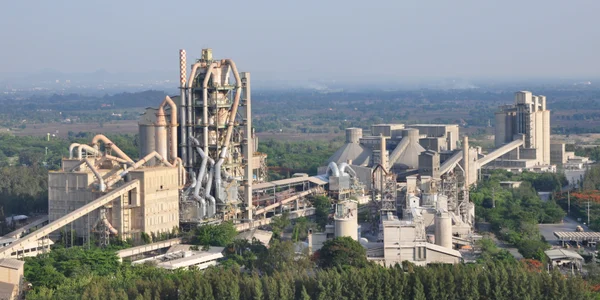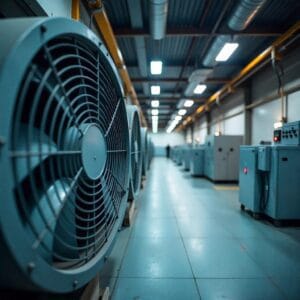Giải pháp lọc không khí và bụi xi măng và khoáng sản
Quá trình trong xi măng và khoáng sản
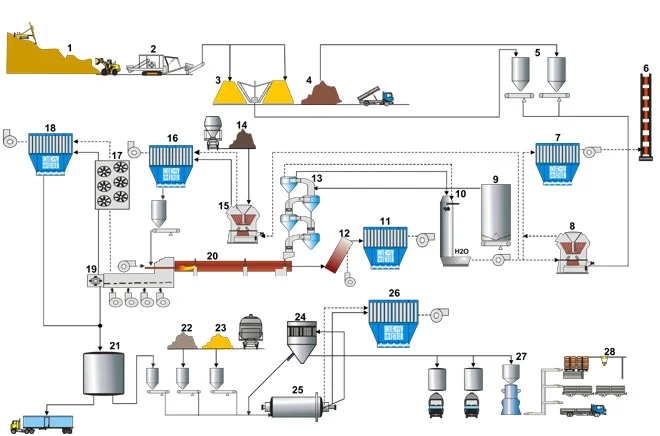
Bộ lọc bên ngoài
Máy sấy phun
Bộ lọc CIP
Giường lưu hóa bên ngoài
Làm đầy
- 1. Mỏ đá
- 2. Nhà máy nghiền
- 3. Đồng nhất nguyên liệu
- 4. Tổng hợp
- 5. Silo nạp liệu cho máy nghiền thô
- 6. Ngăn xếp chính
- 7. Túi lọc cho lò nung/máy nghiền thô
- 8. Máy nghiền thô đứng
- 9. Silo nạp nguyên liệu
- 10. Tháp xử lý khí
- 11. Túi lọc kiềm
- 12. Buồng trộn bỏ qua
- 13. Bộ gia nhiệt trước kiểu Cyclone
- 14. Than thô
- 15. Máy nghiền than đứng
- 16. Túi lọc cho nhà máy nghiền than
- 17. Máy làm mát dạng ống
- 18. Túi lọc cho máy làm mát clinker
- 19. Máy làm mát clinker
- 20. Lò quay
- 21. Silo chứa clinker
- 22. Thạch cao
- 23. Khoáng chất
- 24. Bộ tách
- 25. Máy nghiền xi măng
- 26. Túi lọc cho máy nghiền xi măng
- 27. Nhà máy đóng gói
- 28. Nhà máy xếp pallet
Thông số kỹ thuật bắt buộc
Lọc Tiêu đề PJM
Lọc Tiêu đề PJM
Dữ liệu thiết kế điển hình | Lò nung/xay thô |
|---|---|
Thể tích khí | < 1.200.000 |
Nhiệt độ khí | 85 – 110 hợp chất / < 250 trực tiếp |
Loại bụi | CaCO3, CaO |
Hàm lượng bụi còn lại | < 550 |
Hàm lượng bụi khí thô | < 10 |
Vệ sinh | trực tuyến / ngoại tuyến |
Môi trường lọc | PEA, NX, PPS, PI, GL/PTFE |
Dữ liệu thiết kế điển hình | Bỏ qua kiềm |
|---|---|
Thể tích khí | < 800.000 |
Nhiệt độ khí | < 250 |
Loại bụi | CaCO3, CaO, Kiềm |
Hàm lượng bụi còn lại | < 25 |
Hàm lượng bụi khí thô | < 10 |
Vệ sinh | ngoại tuyến |
Môi trường lọc | PTFE-PI / GL-PTFE |
Lọc tiêu đề IF JCC / IF JC
Bộ làm mát dạng ống IF TC
Dữ liệu thiết kế điển hình | Nhà máy than |
|---|---|
Thể tích khí | < 450.000 |
Nhiệt độ khí | 80 – 110 |
Loại bụi | Than đá |
Hàm lượng bụi còn lại | < 250 |
Hàm lượng bụi khí thô | < 10 |
Vệ sinh | trực tuyến |
Môi trường lọc | ĐẬU HẠT / PAN |
Dữ liệu thiết kế điển hình | Máy làm mát dạng ống |
|---|---|
Thể tích khí | < 1.600.000 |
Nhiệt độ khí trong | 250 – 350 |
Nhiệt độ khí ra | 120 – 200 |
Lọc tiêu đề PJM
Lọc tiêu đề PJM
Dữ liệu thiết kế điển hình | Máy làm mát clinker |
|---|---|
Thể tích khí | < 800.000 |
Nhiệt độ khí | 120 – 180 |
Loại bụi | Clinker |
Hàm lượng bụi khí thô | 10 – 30 |
Hàm lượng bụi còn lại | < 10 |
Vệ sinh | trực tuyến |
Môi trường lọc | PE/NX/PI |
Dữ liệu thiết kế điển hình | Máy nghiền xi măng |
|---|---|
Thể tích khí | < 300.000 |
Nhiệt độ khí | 80 – 110 |
Loại bụi | Xi măng, xỉ |
Hàm lượng bụi khí thô | < 350 |
Hàm lượng bụi còn lại | < 10 |
Vệ sinh | trực tuyến / ngoại tuyến |
Môi trường lọc | PE / ĐẬU HÀ LAN |
Ứng dụng sản phẩm của chúng tôi cho xi măng và khoáng sản
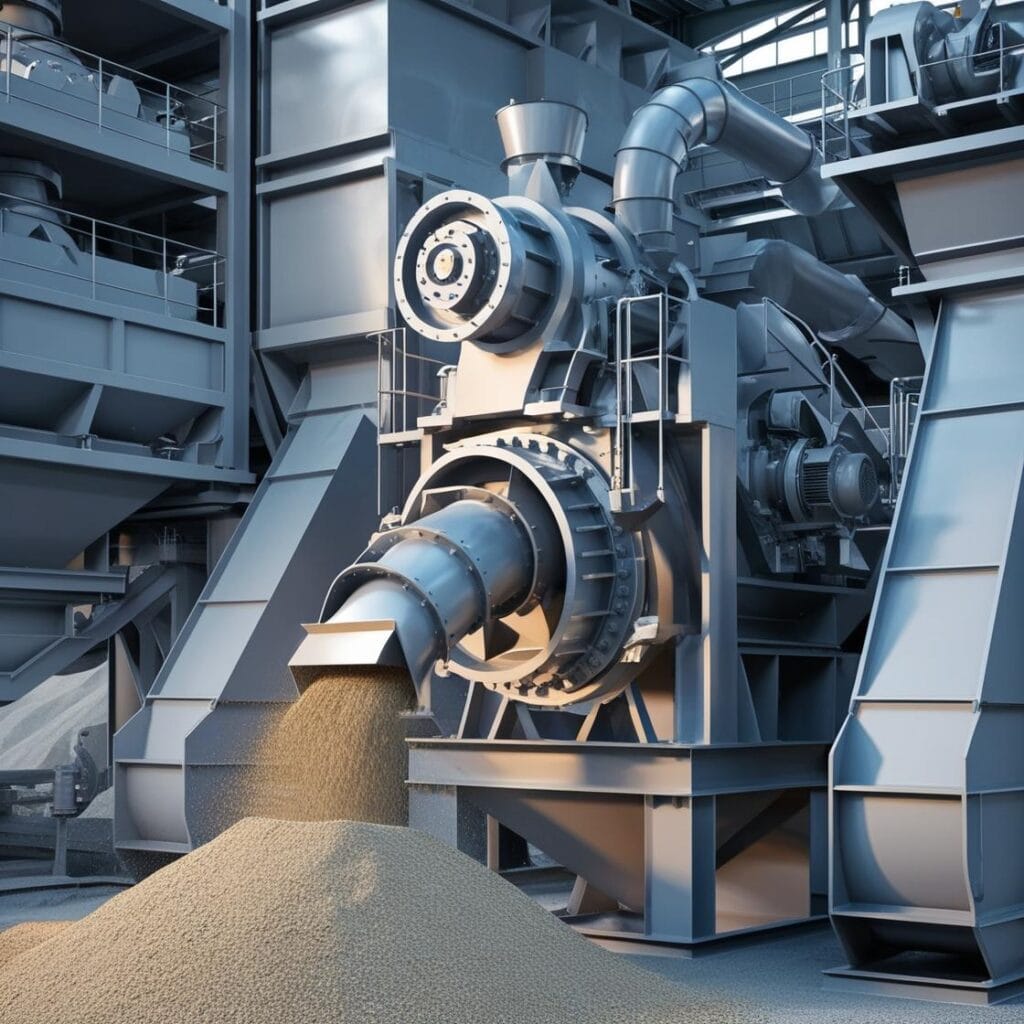
Kiểm soát bụi sinh ra từ quá trình nghiền và xay năng lượng cao, thu giữ các hạt bụi mịn để ngăn chúng thoát ra ngoài khí quyển.
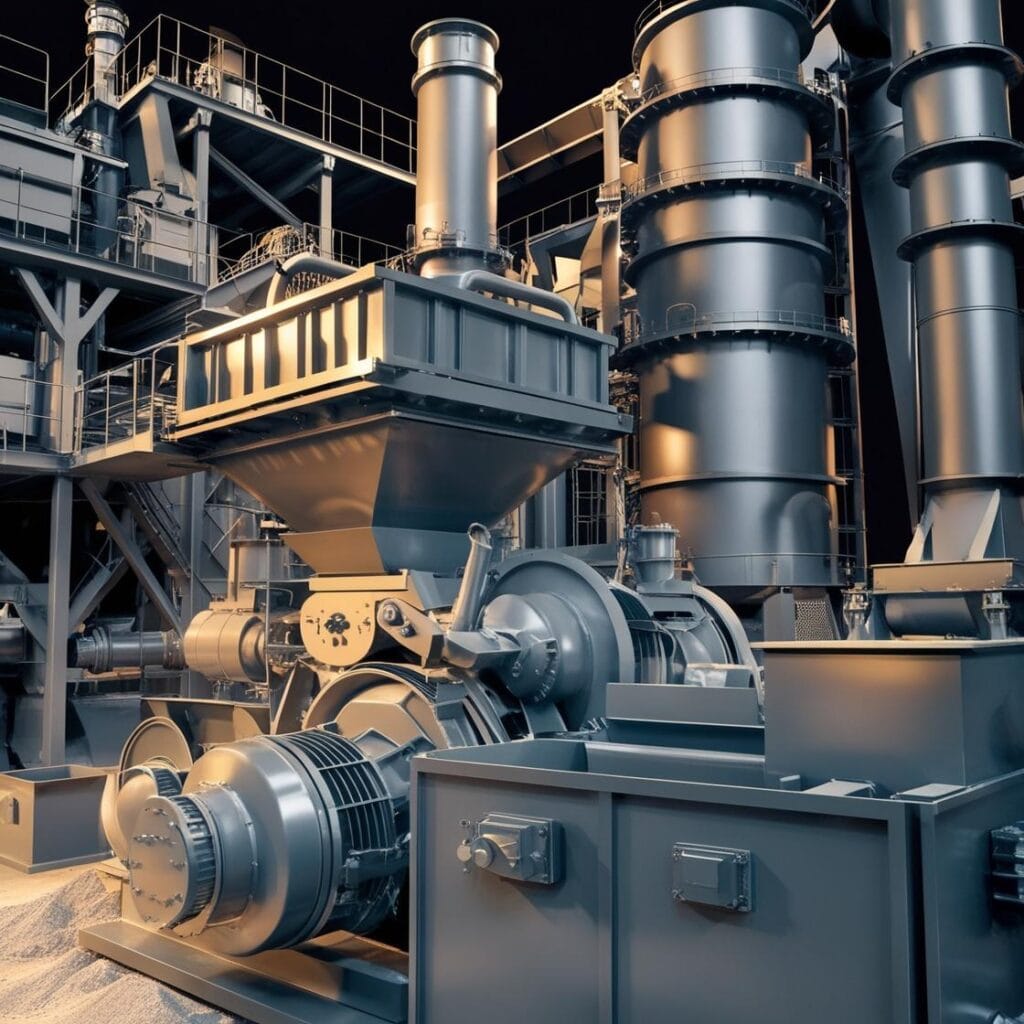
Giảm lượng khí thải từ quá trình nung nóng nguyên liệu thô, kiểm soát bụi và các hạt lơ lửng khác phát sinh trong quá trình sản xuất xi măng.

Thu bụi trong quá trình vận chuyển vật liệu rời, chẳng hạn như đá vôi và clinker, để ngăn ngừa bụi phát tán trong quá trình lưu trữ và vận chuyển.
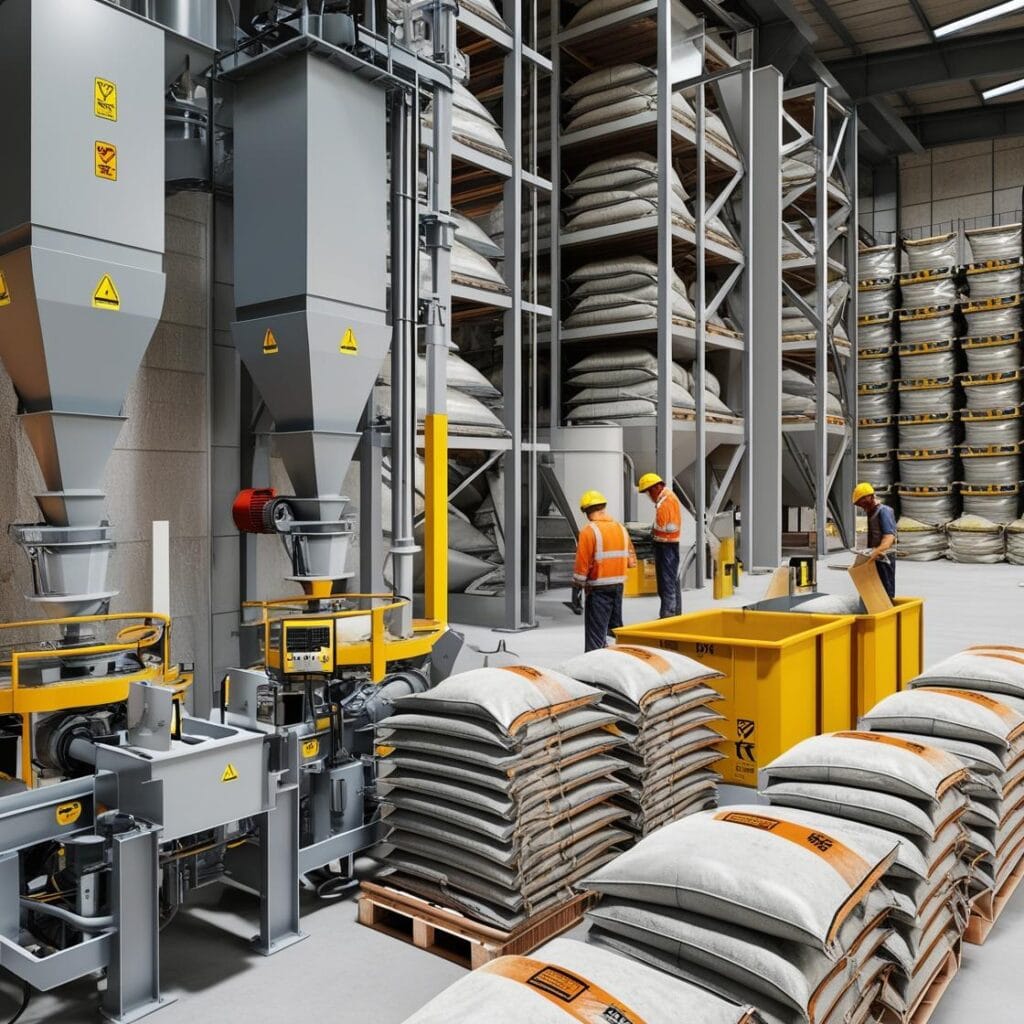
Giảm thiểu bụi phát thải trong khu vực đóng gói và lưu trữ sản phẩm, đảm bảo sản phẩm hoàn thiện được đóng gói và lưu trữ trong môi trường không có chất gây ô nhiễm.
Bối cảnh pháp lý để kiểm soát bụi |
|---|
Tiêu chuẩn chất lượng không khí |
Sức khỏe và An toàn của Người lao động |
Phòng chống cháy nổ |
Bảo vệ môi trường |
Giám sát và báo cáo phát thải |
Hiệu quả năng lượng |
Quản lý chất thải |
Chất lượng và tính nhất quán của sản phẩm |
Giảm thời gian ngừng hoạt động và chi phí bảo trì |
Thách thức kiểm soát bụi |
|---|
Mức độ bụi cao |
Rủi ro sức khỏe của người lao động |
Tuân thủ môi trường |
Nguy cơ cháy nổ |
Mối quan tâm về chất lượng sản phẩm |
Hao mòn thiết bị |
Nhiễm chéo |
Tuân thủ chất lượng không khí |
Sự phát triển của vi sinh vật |
Những cân nhắc chính để kiểm soát bụi hiệu quả |
|---|
Triển khai hệ thống thu bụi hiệu quả |
Kiểm soát luồng không khí và áp suất thích hợp |
Quản lý nhiệt độ và độ ẩm |
Hệ thống lọc hiệu suất cao |
Bảo trì và kiểm tra thường xuyên |
Tuân thủ các tiêu chuẩn công nghiệp |
Đánh giá thường xuyên hệ thống kiểm soát bụi |
Sự điều chỉnh theo quy trình cụ thể |
Đánh giá và giảm thiểu rủi ro |
Kết nối với chúng tôi để được tư vấn chuyên gia
Khám phá các dịch vụ khác của chúng tôi!
Những câu hỏi thường gặp
Trong ngành xi măng, các giải pháp lọc hiệu quả là rất cần thiết để kiểm soát bụi phát thải và đảm bảo tuân thủ quy định về môi trường. Các hệ thống lọc thường được sử dụng bao gồm bộ lọc túi lọc, sử dụng túi lọc vải để thu giữ các hạt mịn từ nhiều quy trình khác nhau như lò nung, nhà máy và xử lý vật liệu. Các bộ lọc này được ưa chuộng nhờ hiệu quả cao trong việc loại bỏ các hạt bụi. Ngoài ra, các giải pháp lọc tiên tiến, chẳng hạn như giải pháp của Micronics, được thiết kế để đáp ứng các nhu cầu đặc thù của ngành xi măng, đảm bảo tuân thủ các quy định về môi trường và nâng cao hiệu quả vận hành.
Hệ thống lọc cải thiện hiệu quả sản xuất xi măng bằng cách thu giữ bụi và các hạt vật chất hiệu quả, giảm hao mòn thiết bị và ngăn ngừa tắc nghẽn. Điều này đảm bảo vận hành trơn tru, giảm thiểu thời gian ngừng hoạt động và nâng cao chất lượng sản phẩm bằng cách ngăn ngừa ô nhiễm. Kiểm soát bụi đúng cách cũng giúp duy trì tuân thủ quy định, giảm thiểu rủi ro bị phạt và các vấn đề môi trường. Ngoài ra, hệ thống lọc hiệu quả còn góp phần tiết kiệm năng lượng bằng cách tối ưu hóa luồng khí và giảm thiểu sụt áp trong hệ thống.
Hệ thống lọc tiên tiến trong sản xuất xi măng giúp giảm thiểu ô nhiễm không khí bằng cách thu giữ các hạt bụi mịn và giảm thiểu phát thải các chất ô nhiễm độc hại. Chúng cải thiện chất lượng không khí, đảm bảo tuân thủ các quy định về môi trường và giảm lượng khí thải carbon của ngành. Bằng cách tăng cường kiểm soát bụi, các hệ thống này cũng góp phần bảo vệ sức khỏe và an toàn cho người lao động. Ngoài ra, chúng còn hỗ trợ phát triển bền vững bằng cách cho phép thu hồi và tái sử dụng nguyên liệu thô, giảm thiểu chất thải và tối ưu hóa hiệu quả năng lượng trong quy trình sản xuất xi măng.

